Wetlands on the Bernardo Wildlife Management Area are getting a facelift this winter as part of an effort to benefit wildlife and outdoor recreationists alike.
Construction work will improve the 1,800-acre property’s water-management system, allowing for more efficient use of what is gradually becoming a more limited resource. Other improvements include habitat enhancements, the construction of a new primitive camping area for hunters, and upgrades to the property’s D-unit that will make it more accessible for hunters with disabilities.
“We’re trying to improve the property in all aspects – being water-wise, improving riparian habitat, allowing hunters easier access and more success,” said Carrie Parris, Habitat Compliance Biologist for the New Mexico Department of Game and Fish. “I’m really excited about this, and I can’t wait for us to break ground and get moving on it.”
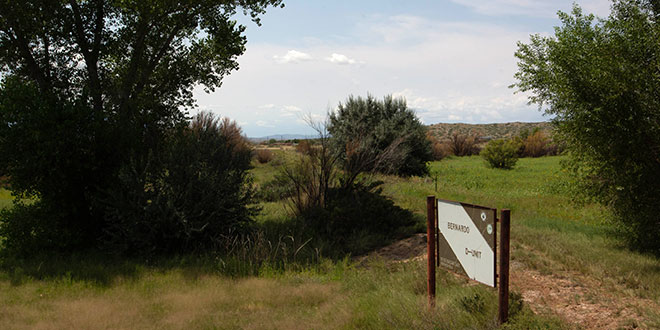
Improving and expanding existing wetland habitat by removing invasive species and installing new infrastructure is one of the project’s primary goals. With thousands of waterfowl descending into the Middle Rio Grande Valley each winter as they migrate south from their breeding grounds in Wyoming, Montana and Southern Canada, adequate cover and food are crucial to the ability of ducks, geese and sandhill cranes to thrive.
“Birds spend one-third or more of their lifetime in the Middle Rio Grande Valley,” said Ryan Darr, the Department’s Wildlife Management Area Lands Manager. “Anything that happens in that area, be it lack of water, lack of food, lack of cover or any pressure, is going to impact the entire life history of these birds and may affect their long-term survival. Subsequently, hunting opportunity as well as public recreation opportunity may be negatively impacted.
“The water woes that we’re facing in New Mexico – and they’re going to get worse throughout time – make it necessary to do something now to improve our water efficiency and try to conserve these wetland habitats before they’re lost forever.”
Ducks Unlimited designed Bernardo’s new layout, as well as that of many other similar wetland projects across North America. The Department is also working with Bosque del Apache National Wildlife Refuge, Sevilleta National Wildlife Refuge, Audubon New Mexico, the Save Our Bosque Task Force and the Middle Rio Grande Conservancy District (MRGCD) to implement the project.
Todd Merendino, biologist for Ducks Unlimited, said Bernardo’s upgrades will make it even more spectacular.
“This is going to be a gem – this is going to be a shining gem,” he said. “There will be tremendous benefits. It’s certainly a significant facelift that has been many, many years in the making. It’s really teeing up those areas for the next 30 years of hunters, birdwatchers and other folks who use the WMA and the waterfowl resources that use the WMA. It’s not off the beaten path where you have to go out of your way to find it – it’s right there off the interstate and easy to get to. This will be a really good opportunity for a lot of people to experience the new features on the WMA.”
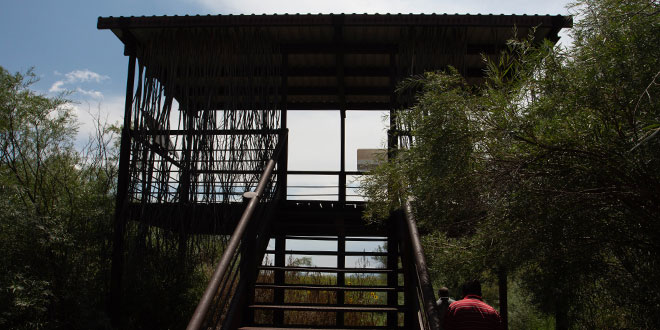
In its current state, Bernardo’s wetland areas are flooded all at once, usually in early November when the Department receives its annual water allotment from the MRGCD. The Department is using knowledge shared by its partners at Bosque del Apache NWR to adjust its wetland management strategy to conserve water and provide maximum benefit to the resource.
“I think any effort within the valley to make water use more efficient helps, especially the downstream users,” said Jeff Sanchez, biologist at Bosque del Apache. “The more water in the system that makes it downstream to farmers and to Bosque del Apache in the valley is always a benefit.”
The kind of project taking place at Bernardo is not an unfamiliar sight in the Middle Rio Grande Valley. A similar project took place at Bosque del Apache NWR, located south of Socorro, providing a template for the Department and its partners to follow.
“They’re pretty much the only people in the Middle Rio Grande Valley that have attempted the type of work that we’re doing,” Parris said of Bosque del Apache. “They are the pioneers, they’ve been really successful at it, they have an adaptive management system that they use, so we’re not going to reinvent the wheel. We’re going to take the lessons that Bosque del Apache NWR has learned and implement those. We have an open dialogue going with the Refuge, and they’ve been really instrumental in helping us figure out how we’re going to manage it once all of these improvements are implemented.”
Bernardo, Bosque del Apache and other properties in the area are all part of the Plan for the Management of Waterfowl and Sandhill Cranes on Federal and State Lands in the Middle Rio Grande Valley in New Mexico, which sets the objectives for these groups of birds. Sanchez shared his expertise with the management at Bernardo, particularly the knowledge gained over the past five years as Bosque del Apache has learned to “create more habitat with less water resources,” he said.
“We have a relationship already where we have set goals and objectives for the Middle Rio Grande Valley as a whole, concerning waterfowl populations, and coordinate our efforts to provide for ducks, cranes and geese,” Sanchez said. “The waterfowl plan really helped us develop that relationship.”
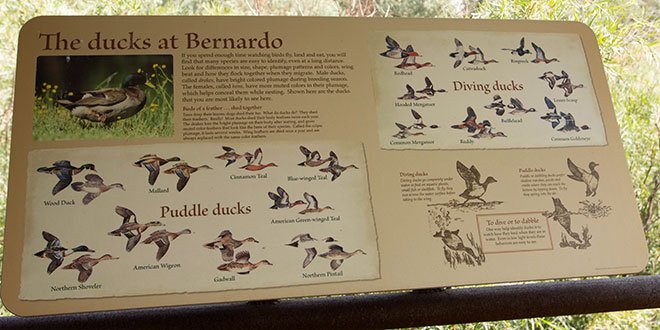
As part of the construction project beginning this winter, the Department will install new infrastructure that will allow it to flood Bernardo’s ponds in a more targeted, slower and staggered manner, maximizing areas for waterfowl to rest and feed as they migrate south for the winter.
“If there is an opportunity to create a wetland somewhere, you better take it because it’s not like you have a wetland every 10 miles,” said Carter Coleman, engineer for Ducks Unlimited. “These habitat areas have a very high level of importance for migrating waterfowl because in a lot of areas in New Mexico, it very well could be 100 miles between one substantial wetland area and another, if not further. This habitat creation is integrally important to support large-scale migration of waterfowl across the state of New Mexico.”
Coleman noted that designing a wetland project in New Mexico can be difficult for a number of reasons.
“From an engineering standpoint, doing work in New Mexico is challenging as it pertains to water,” he said. “The state of New Mexico does a lot of really creative and labor-intensive things to move water great distances across the landscape to flood areas. There are miles and miles and miles of open-channel ditch that are used to route water to Bernardo, and that is very unique to New Mexico and subsequently drives up costs.”
The Department plans to rehabilitate existing wells to flood certain areas in time for the early teal hunt. The Department will then work with its partners at the MRGCD to deliver excess surface water purchased annually by the Department beginning in October. Surface water will be used to slowly flood Bernardo’s main units throughout the winter.
Slow flood up is beneficial because “dabbling waterfowl largely feed on seeds that are right at water level or a few inches below,” Darr said. “If we flood units up very quickly and all of my seeds are under a foot of water, they’re just going to rot. If we start, and over a month, slowly raise that water level as the birds come in, they can feed throughout that entire column of forage.”
By flooding various units across the WMA in a staggered manner, food availability will be increased throughout the entire winter. Some will start being flooded in October, some in November and some in December.
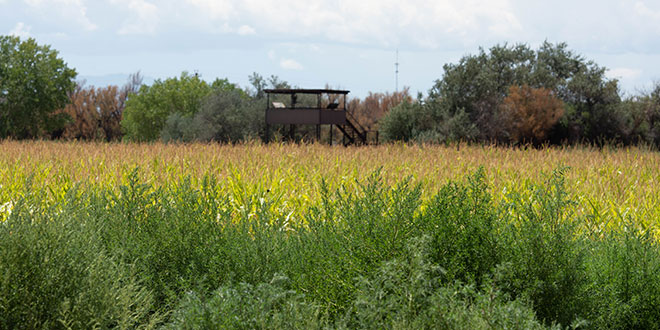
Flooding wetlands in a slow and staggered manner will reduce the amount of time water is on the ground, leading to major water savings, while still maximizing food availability for wildlife. These actions will, in turn, improve hunting and wildlife viewing opportunities.
Upgrades to Bernardo’s water-delivery infrastructure will also serve to make the property more water-efficient. Much of the water-delivery system will be converted from open, dirt ditches to enclosed piping. Additionally, aging pipes, crumbling concrete and the inability to return water into ditches and canals have led to water loss.
Corroding pipes have been a constant problem because of soil-salinity issues. The project will see metal pipes replaced by longer-lasting plastic.
“(The salt) will eat a metal pipe structure pretty fast,” said Bernardo farm manager Milnor Lucero. “They tried to do galvanized (steel) and galvanized lasts a little bit longer. They tried to do aluminum pipes at one point, but they’re soft metal, so they don’t last as long. We’ve tried almost everything.
“We’ve already done a lot of trial-and-error throughout the years, and I think what we’re figuring out is that the new pipeline system is going to be a definite advantage,” Lucero added.
Finding a remedy to water-loss issues has become even more important in recent years, as long-term drought and increased water usage has made for less available water for wetlands as well as other users in the Middle Rio Grande Valley.
“(The Department is) being really proactive in planning for possible impacts due to climate change on water supply and trying to get as efficient as possible, getting engaged with the (Middle Rio Grande Conservancy District) as a partner to try to optimize that whole situation,” said Mike Hamman, Chief Executive Officer for the MRGCD. “They’re not letting (climate change) force them into it. They’re looking ahead and trying to be responsible water managers in a water-tight situation in relation to the rest of the demand in the valley.
“We’ve come out of a period that I like to call ‘fat and happy’ water-wise,” Hamman added. “It’s actually been degrading for the last eight years or so in terms of annual availability of water, but we’ve done OK and we just sort of accept the operational needs of the refuges and the Wildlife Management Areas just because we’ve sort of had a little extra water as the season winds down. Now, it’s gotten to the point where it’s really tight.”
Chuck Schultz, Northwest Regional Habitat Biologist for the Department, said the change to the infrastructure will improve soil conditions. The ability to flush water through the system will also help reduce the likelihood of disease outbreaks among waterfowl.
“One of the changes that we’re putting in place is to give ourselves the ability to move water out of our wetlands if needed,” he said. “With our current wetland design and infrastructure, we are unable to flush water through most of our wetlands. This has allowed salts and other minerals to build up to the detriment of soil and plant health.”
The additional flexibility provided by Bernardo’s new water-management infrastructure will also allow for managers to create areas that are more conducive to certain species, as well as making it easier to manage invasive species, said Paul Tashjian, Director of Freshwater Conservation for Audubon Southwest.
“The more you can fine-tune how you manage water within a wetland, you can really manage the system for the plants and the species that you want – you can optimize for them if you have that kind of flexibility,” Tashjian said. “When it’s all-or-nothing, you can have water standing in the unit when you really want it to be dry or vice versa, and it can lead to a lot of weeds and a lot of invasive plants that you don’t really want.”
Hunters, birdwatchers, hikers and other property users will also notice improved access once the project is complete. Currently, there is limited parking, forcing visitors to park their vehicles either along U.S. Highway 60, creating a potential traffic hazard, or along the roads within Bernardo, which can become muddy and rutted. However, the project includes the construction of additional designated parking areas, as well as road improvements.
“We did have problems in the past few years of people parking on (U.S. Highway 60) up there,” said conservation officer Jeremy Smith, sergeant in the Grants District for the Department. “We tried to nip that in the bud and get people off that highway because it’s really dangerous for people pulling in and out of there (on Highway 60).”
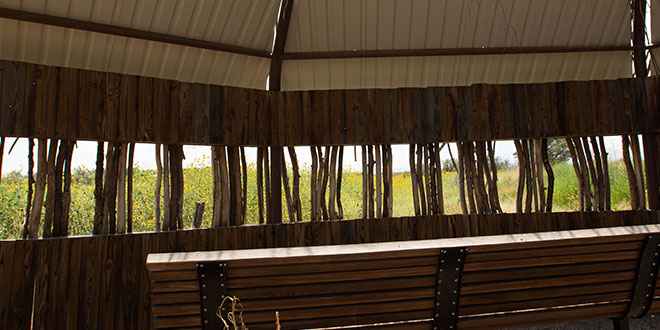
In addition, the project includes the construction of an Americans with Disabilities Act (ADA)-compliant hunting area located in Bernardo’s D-Unit just north of U.S. Highway 60. Parking areas, hunting blinds and pathways will all be constructed to ADA standards, giving hunters with disabilities and mobility impairments better access to the property and a more successful experience.
The project also includes the construction of a camping area immediately south of U.S. Highway 60. Open to licensed hunters only, the area – which will not have hook-ups but will have vault toilets available – will enable hunters to avoid staying in nearby hotels or traveling long distances the morning of their hunt.
All these improvements will lead to enhanced hunting opportunities, with more birds taking advantage of the upgraded wetland habitat and better access allowing hunters to spread out across the property, rather than being packed into a small area and trying to hunt a smaller number of waterfowl.
“The whole purpose of the (new) layout is to spread out hunters, give more huntable acres and more access – (which is) less dangerous to the hunters themselves, but also a better experience because there’s going to be more water, more acreage and more habitat in general,” Smith said. “We’re pretty excited because it’s one of those projects that once it’s done, it should have a positive effect for a long time.”
The work at Bernardo will also ultimately benefit other species, such as the southwest willow flycatcher and yellow-billed cuckoo, which are currently affected by limited and lower-quality habitat.
“Right now, especially for both the cuckoo and the flycatcher, the majority of our birds are down at Elephant Butte Lake, which isn’t a great place to be, as we have all of our eggs in one basket” said Deb Hill, Large River Restoration and Recovery Supervisor for the United States Fish and Wildlife Service. “The north end of Elephant Butte Lake will eventually outgrow being habitat. We would prefer having habitat patches spread north from Elephant Butte throughout the Middle Rio Grande Valley, as habitat patches become available.”
Construction work is planned to begin north of U.S. Highway 60, where there currently is no hunting taking place. According to Darr, work may shift to the Bernardo Ponds area once hunting slows down, with the Bernardo Quagmire remaining flooded and open to hunting this season. Once work on the ponds is complete, they will reopen to hunters, with work beginning on the Quagmire. This staggered approach will ensure that at least part of the wetlands will be open to hunters throughout the project.
There will be no construction at nearby La Joya WMA this year, allowing hunters another option. Hunting is also available on the north end of Sevilleta NWR, located west of Interstate 25. Hunters are encouraged to contact the Department’s Information Center at (888) 248-6866 with any questions regarding additional hunting opportunities.
Three-fourths of the funding for the Bernardo project comes from the U.S. Fish and Wildlife Service – particularly from a federal excise tax on firearms, ammunition and archery equipment, known as the Pittman-Robertson Act. The remaining 25% of funding comes from funds generated through the Habitat Management & Access Validation (HMAV) fee, purchased annually by licensed hunters and anglers aged 17 and older in New Mexico.
“It’s money from sportswomen and sportsmen being reinvested for their use, for the wildlife, the wildlife habitat and for the general public to come out and recreate,” Darr said.
 New Mexico Wildlife magazine Conserving New Mexico's Wildlife for Future Generations
New Mexico Wildlife magazine Conserving New Mexico's Wildlife for Future Generations
